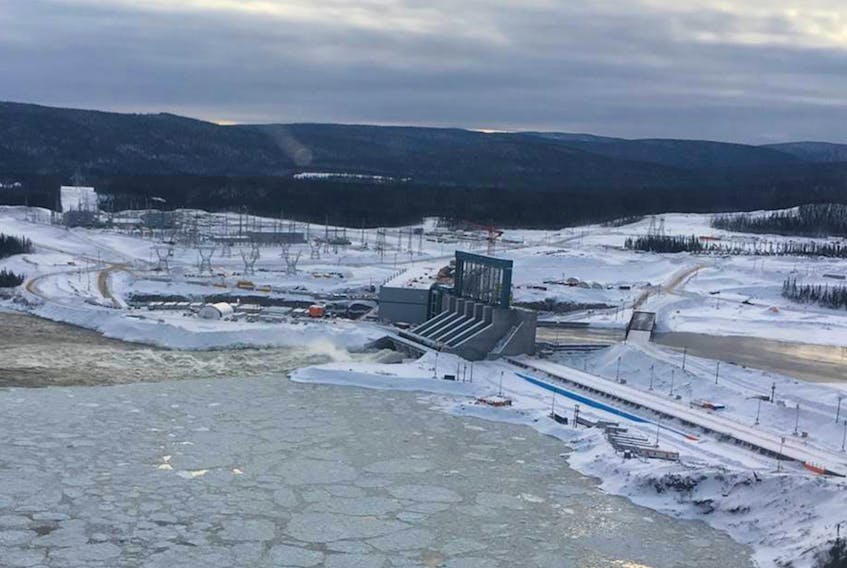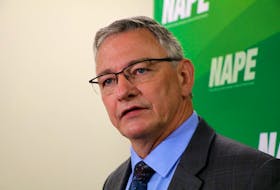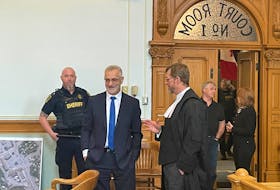The Independent Expert Advisory Committee (IEAC) for the Muskrat Falls hydroelectric project has recommended the removal of more organic material from the area of what will be the hydro dam’s reservoir.
The recommendation is intended to both reduce the amount of the neurotoxin methylmercury released in the reservoir’s creation, and the duration of methylmercury release after full flooding.
The committee chair has written provincial Environment Minister Eddie Joyce, formally calling on government to cap wetland in the area and even dig out some of the soil.
Speaking to reporters shortly after 11 a.m., Joyce said the department will be taking time to further review the science behind the recommendation, plus speak with the committee chair and Indigenous governments.
Related links:
Responses from federal regulators on Muskrat Falls
That dam project: Who gets to say no?
The planned reservoir covers roughly 101 square kilometres, including 41 square kilometres of land to be flooded during maximum water storage.
According to project lead Nalcor Energy, SNC-Lavalin has estimated the targeted soil removal will cost between $409 million and $742 million, not including contingency funds, contractor risk premiums and costs associated with additional project delays. There would be more for capping wetland.
The Muskrat Falls project is already well behind schedule and over budget, at an estimated cost of $12.7 billion, up from an early estimate of about $6.2 billion and is the subject of an ongoing commission of inquiry.
However, as Carl McLean, the Nunatsiavut Government’s representative on the committee stated, “we feel that the potential impacts and risks in not implementing additional mitigation measures prior to flooding are too high.”
In addition to the recommendation for additional work at the reservoir on the Churchill River, the committee has called for an independent body to oversee a community-based methylmercury monitoring program for residents downstream, the posting of an “impact security fund” to be used in case of future restrictions on consumption of country foods (fish and other wildlife) due to methylmercury contamination.
There is also a recommendation for immediate communication with people in the area that country foods are currently safe to eat and remain an important means of maintaining health in the local communities.
While most recommendations coming from the IEAC had unanimous support, there were dissenting opinions as to the additional mitigation at the reservoir, including from the Innu Nation, Nalcor Energy and the provincial government.
Through representatives Greg Nuna and Peter Penashue, the Innu Nation has questioned the process by which the committee’s recommendation came to be, suggesting it does not reflect the recommendations of committee scientists.
A representative for Natural Resources Canada has pointed to the lack of consensus on what to do with the reservoir area, recommending some consensus be reached before final decisions are made.
The background
The advisory committee was created following an agreement between area governments, at a marathon meeting at Confederation Building in St. John’s, on Oct. 25, 2016.
The meeting was intended to address ongoing protest action — calls for the project to be halted, given ongoing concerns around human health and cultural preservation.
There had been action in Ottawa, led by hunger strikers Billy Gauthier, Delilah Saunders and Jerry Kohlmeister; an occupation of the main work site in Labrador, led by the Labrador Land Protectors; and a campaign called Make Muskrat Right initiated by the Inuit government of Nunatsiavut (with a land claim reaching into Lake Melville, where the Churchill River empties).
The Government of Nunatsiavut had sought additional research on the production of neurotoxin methylmercury as a result of the dam’s creation, and the potential human health effects downstream, independent of the provincial government and Crown corporation leading the project. The results led to greater concerns within the community.
The committee — science and Indigenous knowledge
The committee actually has two distinct levels of operation — the scientific and Indigenous advisory level, and the political oversight level.
The committee’s science and advisory level involves committee chairman Ken Reimer, research director Marine Biasutti-Brown, plus six scientist advisors and three members offering Indigenous knowledge (collectively: David Wolfrey, David Lean, Jane Kirk, Wolfgang Jansen, Etienne Pone, Maureen Baikie, Trevor Bell, James McCarthy and Stewart Michelin).
Their work to date has included a review of existing research relevant to understanding methylmercury in the context of the Muskrat Falls project, identifying knowledge gaps. Then, following initial recommendations, there was the commissioning of new studies to begin to fill those gaps.
New studies included: a statistical analysis of Nalcor Energy’s water monitoring data, by Iris Koch, with the environmental sciences group at the Royal Military College of Canada; a study of local soil cores and the release of methylmercury under varying conditions, by Elsie Sunderland of Harvard University; and predictive models for methylmercury production for the reservoir area, by Ryan Calder at Duke University.
The Calder study was scheduled to wrap at the end of March.
Everything from findings from the examination of past research, to the decisions on new research projects are said to have been developed through consensus of the scientific and Indigenous advisory group, with the chairman holding a deciding vote if required.
The committee — Political oversight
The next level of the committee is the oversight group, including one representative from each of the Nunatsiavut Government, Innu Nation, NunatuKavut Community Council, the provincial government (non-voting), federal government (non-voting) and Nalcor Energy (non-voting).
The oversight group has voted on recommendations from the science and advisory group, adding individual responses, to provide a clearer picture of points of agreement and disagreement on how to best proceed given the research.
The vote on the recommendations for additional measures at the reservoir was split, with Nunatsiavut and NunatuKavut voting in favour, and the Innu Nation against.
Nunatsiavut's Minister of Lands and Natural Resources Darryl Shiwak, speaking by phone from Makkovik, said his government believes all of the committee's recommendations are important, but the next step is to see what the response is from the Government of Newfoundland and Labrador.
For his part, premier Dwight Ball told The Telegram he had remained hands off when it came to participation in the committee's work. Prior to the morning press conference, he said he spoke with Joyce and supports obtaining a better understanding of the recommendation and positions of all governments before final decisions on the reservoir clearing.
He was asked if Muskrat Falls had been a topic of conversation in Ottawa during his meeting with prime minister Justin Trudeau on Tuesday.
"Muskrat Falls didn't come up at all," he said.
In an emailed response to questions, a spokeswoman for Nalcor Energy said the company is reviewing the recommendations and opinions of IEAC members. "We will work with the provincial government as necessary should they require any additional information as they review the (committee's) information in relation to the mitigation, monitoring and health management recommendations," it stated.
The Telegram is following the story.
(NOTE: Updated shortly before noon NST, to include responses from the premier and provincial Environment minister. Addition made shortly after to clarify estimated additional costs. At 12:45 p.m. NST, updated to add response from Nalcor Energy. Comment from Nunatsiavut minister Darryl Shiwak added at 2:50 p.m. NST.)









